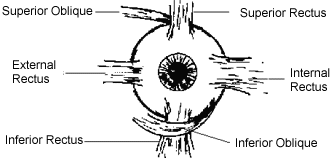< Page 6 of 9>
1 2 3 4 5 6 7 8 9
Anatomy
& Physiology
Extra-Ocular
Muscles

Phoria: A constant
tendency for the eyes to turn from the normal position for binocular
vision.
Tropia: A definate and obvious turning of the eyes from
the normal position for binocular vision.
|
Examples
|
|
| Exo: Out, Right exophoria | A tendancy of the right eye to turn outward |
| Eso: In, Left esotropia | A definate turning inward of the left eye |
| Hyper: Up, Right hyperphoria | A tendency of the right eye to turn upward |
| Hypo: Down, Left hypotropia | A definate turning downward of the left eye |
The extra-ocular muscles are inserted into the sclera and cause each eye to rotate in all possible directions. There are six of these muscles in each eye. These are: the temporal rectus, nasal rectus, superior rectus, inferior rectus, superior oblique, and inferior oblique. When the muscles are working properly the two eyes can work together, enabling the brain to fuse the two images it receives into one. If one or more of these muscles is weaker or stronger than normal, the eyes may not be able to move in perfect unison. The resulting imbalance can make fusion difficult or even impossible, resulting in diplopia (double vision). Very often an element in the prescription called prism will be prescribed to help alleviate this problem.
< Page 6 of 9>
1 2 3 4 5 6 7 8 9